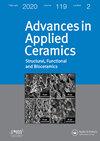A review on the manufacturing techniques of porous hydrophobic ceramic membranes applied to direct contact membrane distillation
IF 1.6
4区 材料科学
Q3 MATERIALS SCIENCE, CERAMICS
引用次数: 5
Abstract
ABSTRACT Porous hydrophobic ceramic membranes have been increasingly applied in advanced membrane-based separation processes such as Direct Contact Membrane Distillation (DCMD) due to their higher chemical and mechanical resistances. The development of novel ceramic membranes enhanced with porosity is based on conventional techniques such as extrusion and tape casting, and unique processing such as dry–wet spinning and vacuum filtration. The relationships between shaping and surface hydrophobization related to the membrane structure, properties and performance of the ceramic membrane applied to DCMD are explained in this work. The manufacturing technique influences the membrane characteristics, and consequently the permeability in DCMD. Recent research is focused on manufacturing high porous hollow fibre ceramic membranes by dry–wet spinning. In contrast to the grafting of alkylsilanes, the chemical vapour deposition process has been applied as an effective surface modifying technique to enhance membrane hydrophobicity. Ceramic membranes are mostly applied to desalination in DCMD and have been little researched concerning the unique properties they can offer, such as superhydrophobicity and use in a harsh environment. In addition to the review of manufacturing techniques, polymer-derived ceramic (PDC) is proposed as a one-step ceramic membrane processing route for DCMD. Although only a handful of works addressed the use of PDC membranes applied to DCMD, the great potential of these materials is forecast.应用于直接接触膜蒸馏的多孔疏水陶瓷膜制备技术综述
多孔疏水陶瓷膜由于具有较高的耐化学性和机械性能,在直接接触膜蒸馏(DCMD)等先进的膜分离工艺中得到了越来越多的应用。新型多孔陶瓷膜的开发是基于传统的挤压和带铸等技术,以及干湿纺丝和真空过滤等独特的工艺。本文阐述了陶瓷膜的结构、性能和成型与表面疏水性之间的关系。制备工艺会影响膜的特性,从而影响dmd的渗透性。干湿纺丝法制备高孔中空陶瓷纤维膜是近年来研究的热点。与烷基硅烷接枝相比,化学气相沉积工艺是一种有效的增强膜疏水性的表面改性技术。陶瓷膜主要应用于dmd海水淡化,其独特的性能,如超疏水性和在恶劣环境下的使用,研究很少。综述了聚合物衍生陶瓷膜的制备工艺,提出了聚合物衍生陶瓷膜的一步法制备工艺路线。虽然只有少数研究工作涉及PDC膜在DCMD中的应用,但预测了这些材料的巨大潜力。
本文章由计算机程序翻译,如有差异,请以英文原文为准。
求助全文
约1分钟内获得全文
求助全文
来源期刊

Advances in Applied Ceramics
工程技术-材料科学:硅酸盐
CiteScore
4.40
自引率
4.50%
发文量
17
审稿时长
5.2 months
期刊介绍:
Advances in Applied Ceramics: Structural, Functional and Bioceramics provides international coverage of high-quality research on functional ceramics, engineering ceramics and bioceramics.
 求助内容:
求助内容: 应助结果提醒方式:
应助结果提醒方式:


